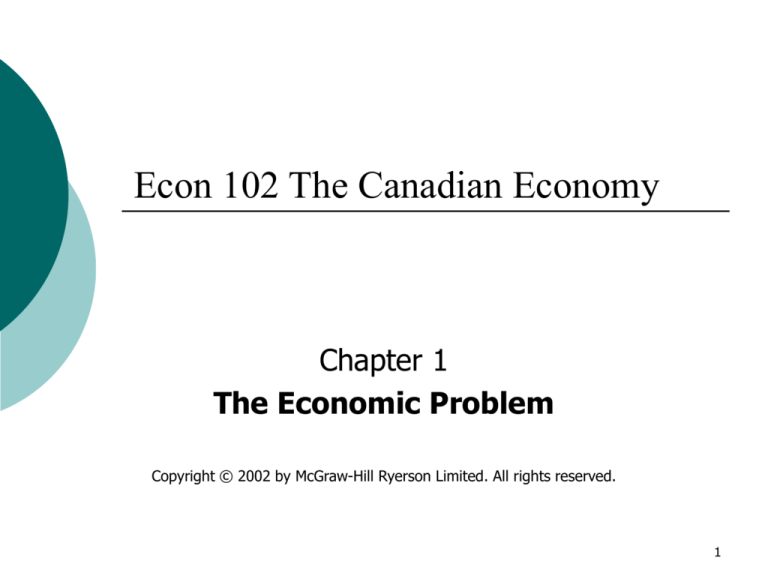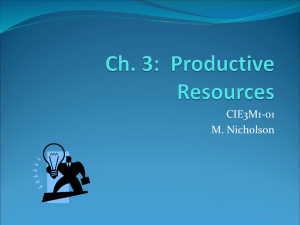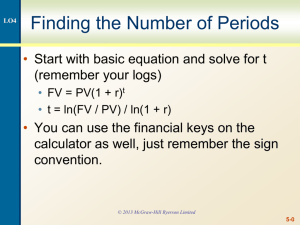
Econ 102 The Canadian Economy
Chapter 1
The Economic Problem
Copyright © 2002 by McGraw-Hill Ryerson Limited. All rights reserved.
1
Chapter Objectives
In this chapter, you will:
consider the economic problem that underlies
the definition of economics;
learn about the way economists specify
economic choice;
examine the production choices an entire
economy faces, as demonstrated by the
production possibilities model;
analyze the three basic economic questions
and how various economic systems answer
them.
Copyright © 2002 by McGraw-Hill Ryerson Limited. All rights reserved.
2
Outline of Topics
1.1 What Economists Do
1.2 Economic Choice
1.3 The Production Possibilities Model
1.4 Economic Systems
3
1.1 What Economists Do
The Economic Problem
Economists deal with the economic problem.
Economic agents must continually make
choices.
Their wants are unlimited.
They face a limited supply of economic
resources.
Economic resources
including natural, capital, and human
resources ( see Definitions on page 3)
4
1.1 What Economists Do
Economics Defined
Economics is the study of how to
distribute scarce resources among
competing ends.
Microeconomics focuses on individual
consumers and businesses.
Macroeconomics takes a broad view of
the economy.
Copyright © 2002 by McGraw-Hill Ryerson Limited. All rights reserved.
5
1.1 What Economists Do
Economic Models
Economic models:
simplify economic reality
show how dependent variables are affected by
independent variables
include inverse and/or direct relationships
incorporate a variety of assumptions such as ceteris
paribus
are classified as part of either positive economics
or normative economics
(See Definitions on page 5 & 6)
Copyright © 2002 by McGraw-Hill Ryerson Limited. All rights reserved.
6
1.2 Economic Choice
Utility Maximization
Economists assume that economic decisionmakers maximize their own utility.
Utility: the satisfaction gained from any
action
Decision-makers must keep in mind the
opportunity cost of each alternative.
Opportunity cost: the utility that could
have been gained by choosing an action’s
best alternative.
Copyright © 2002 by McGraw-Hill Ryerson Limited. All rights reserved.
7
1.3 The Production Possibilities
Model
The production possibilities model is based on
three assumptions:
an economy makes only two products
resources and technology are fixed
all resources are employed to their fullest
capacity
Copyright © 2002 by McGraw-Hill Ryerson Limited. All rights reserved.
8
1.3 The Production Possibilities Model
The Production Possibilities Curve (a)
The production possibilities curve shows a
range of possible output combinations for an
economy.
It highlights the scarcity of resources.
It has a concave shape, which reflects the
law of increasing opportunity costs.
Copyright © 2002 by McGraw-Hill Ryerson Limited. All rights reserved.
9
The Production Possibilities Curve (b)
Figure 1.1, page 8
Production Possibilities
Schedule
Production Possibilities Curve
a
1000
b
f
Hamburgers Computers
point
on graph
1000
0
a
900
1
b
600
2
c
0
3
d
Hamburgers
900
unattainable
c
600
e
inefficient
d
0
1
2
3
Computers
Copyright © 2002 by McGraw-Hill Ryerson Limited. All rights reserved.
10
The Law of Increasing Opportunity Costs
Figure 1.2, page 10
Hamburgers
Opportunity Computers point
Cost of
on graph
Computers
1000
0
a
100
900
1
b
2
c
Production Possibilities Curve
a
1000
As the quantity
of computers
rises, so does their
opportunity cost.
b
900
Hamburgers
Production Possibilities Schedule
c
600
300
600
600
0
d
3
d
0
1
2
3
Computers
Copyright © 2002 by McGraw-Hill Ryerson Limited. All rights reserved.
11
Economic Growth:
Outward Shifts in Production Possibilities
Production Possibilities Curve
With more
computers, the
curve shifts out
in the next
period.
Hamburgers
1000
0
3
Computers
Copyright © 2002 by McGraw-Hill Ryerson Limited. All rights reserved.
12
1.4 Economic Systems
Economic Systems: the organization of an
economy, which represents a country’s distinct
set of social customs, political institutions, and
economic practices
The Basic Economic Questions: There are three basic
questions any society must answer:
what to produce
how to produce
for whom to produce
Copyright © 2002 by McGraw-Hill Ryerson Limited. All rights reserved.
13
1.4 Economic Systems
There are three systems to choose from:
Traditional Economy: an economic system in
which economic decisions are made on the basis
of custom.
Traditional economies focus on non-economic
concerns and have tight social constraints.
14
1.4 Economic Systems
Market Economy: an economic system based on private
ownership and the use of markets in economic decisionmaking
Market economies are consumer-centered and innovative
but create inequality and instability.
Benefits:
Consumer sovereignty: the decision of what to
produce is ultimately guided by the needs and
wants of household in their role as consumers
Innovation
Copyright © 2002 by McGraw-Hill Ryerson Limited. All rights reserved.
15
1.4 Economic Systems
Drawbacks:
Inequities of income distribution
Possible market problems: eg, pollution
Possible Instability of total output
Command Economy: an economic system based on
public ownership and central planning.
Benefits:
Distribute income equally
Economic growth
16
1.4 Economic Systems
Drawbacks:
Planning difficulties
Inefficiencies
A lack of freedom.
17
1.4 Economic Systems
Mixed Economy
Most countries fall between the extremes of
traditional, market, and command economies.
Modern mixed economies: an economic system
that combines aspects of a market economy
and a command economy; production decisions
are made both in private markets and by
government
Traditional mixed economies: economic
systems in which a traditional sectors co-exists
with modern sectors
Copyright © 2002 by McGraw-Hill Ryerson Limited. All rights reserved.
18
The Range of Economic Systems
Figure 1.4, page 16
Copyright © 2002 by McGraw-Hill Ryerson Limited. All rights reserved.
19
1.4 Economic System
Economic Goals
There are seven major economic goals:
economic efficiency
income equity
price stability
full employment
viable balance of payments
economic growth
environmental sustainability
Copyright © 2002 by McGraw-Hill Ryerson Limited. All rights reserved.
20
1.4 Economic System
Complementary and Conflicting Economic
Goals
Economic goals may be complementary.
An example is the relationship between full
employment and economic growth.
Economic goals may be conflicting.
An example is the relationship between
price stability and full employment.
Copyright © 2002 by McGraw-Hill Ryerson Limited. All rights reserved.
21
The Founder of Modern Economics
Adam Smith:
explained how the division of labour
increases production
argued that self interest is transformed by
the invisible hand of competition so that it
creates significant economic benefits
stressed the principle of laissez faire, which
means that governments should not
intervene in economic activity
Copyright © 2002 by McGraw-Hill Ryerson Limited. All rights reserved.
22




